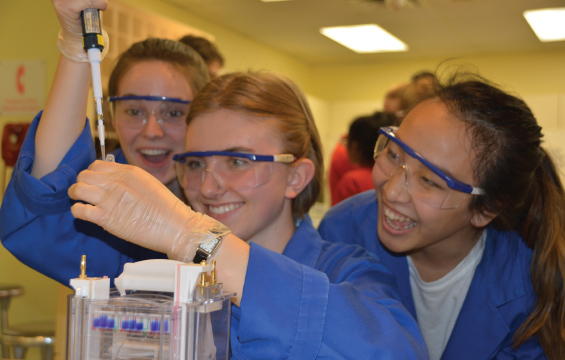DNA Fingerprinting
On-Site School Program

Curriculum Connections:
Strands A, B and D : Scientific Investigation Skills, Biochemistry & Molecular Genetics
| A1.4 | apply knowledge and understanding of safe laboratory practices and procedures when planning investigations by correctly interpreting Workplace Hazardous Materials Information System (WHMIS) symbols; by using appropriate techniques for handling and storing laboratory equipment and materials and disposing of laboratory and biological materials (e.g., plants and invertebrates); and by using appropriate personal protection |
|---|---|
| A1.5 | conduct inquiries, controlling relevant variables, adapting or extending procedures as required, and using appropriate materials and equipment safely, accurately, and effectively, to collect observations and data |
| A1.8 | synthesize, analyse, interpret, and evaluate qualitative and/or quantitative data to determine whether the evidence supports or refutes the initial prediction or hypothesis and whether it is consistent with scientific theory; identify sources of bias and/or error; and suggest improvements to the inquiry to reduce the likelihood of error |
| A1.10 | draw conclusions based on inquiry results and research findings, and justify their conclusions with reference to scientific knowledge |
| A2.1 | identify and describe a variety of careers related to the fields of science under study (e.g., scientific journalist, fisheries and wildlife officer, physician, infectious disease researcher, geneticist) and the education and training necessary for these careers |
| B1.2 | evaluate, on the basis of research, some advances in cellular biology and related technological applications |
| B2.1 | use appropriate terminology related to biochemistry, including, but not limited to: active and passive transport, covalent and ionic bond, allosteric site, substrate, substrate-enzyme complex, and inhibition |
| B2.5 | plan and conduct an investigation related to a cellular process, using appropriate laboratory equipment and techniques, and report the results in an appropriate format |
| B3.2 | describe the structure of important biochemical compounds, including carbohydrates, proteins, lipids, and nucleic acids, and explain their function within cells |
| B3.4 | describe the chemical structures and mechanisms of various enzymes |
| D1.1 | analyse, on the basis of research, some of the social, ethical, and legal implications of biotechnology |
| D2.1 | use appropriate terminology related to molecular genetics, including, but not limited to: polymerase I, II, and III, DNA ligase, helicase, Okazaki fragment, mRNA, rRNA, tRNA, codon, anticodon, translation, transcription, and ribosome subunits |
| D2.2 | analyse a simulated strand of DNA to determine the genetic code and base pairing of DNA |
| D2.3 | conduct an investigation to extract DNA from a specimen of plant or animal protein |
| D3.1 | explain the current model of DNA replication, and describe the different repair mechanisms that can correct mistakes in DNA sequencing |
| D3.6 | describe the functions of some of the cell components used in biotechnology |
| D3.7 | describe, on the basis of research, some of the historical scientific contributions that have advanced our understanding of molecular genetics |
Strands A and F : Scientific Investigation Skills & Biotechnology
| A1.4 | apply knowledge and understanding of safe laboratory practices and procedures when planning investigations by correctly interpreting Workplace Hazardous Materials Information System (WHMIS) symbols; by using appropriate techniques for handling and storing laboratory equipment and materials and disposing of laboratory materials, including biological waste (e.g., techniques to prevent contamination of specimens); and by using appropriate personal protection (e.g., wearing gloves when handling biological specimens) |
|---|---|
| A1.5 | conduct inquiries, controlling relevant variables, adapting or extending procedures as required, and using appropriate materials and equipment safely, accurately, and effectively, to collect observations and data |
| A1.8 | synthesize, analyse, interpret, and evaluate qualitative and/or quantitative data to determine whether the evidence supports or refutes the initial prediction or hypothesis and whether it is consistent with scientific theory; identify sources of bias and/or error; and suggest improvements to the inquiry to reduce the likelihood of error |
| A1.10 | draw conclusions based on inquiry results and research findings, and justify their conclusions with reference to scientific knowledge |
| A2.1 | identify and describe a variety of careers related to the fields of science under study (e.g., nuclear medicine technician, nurse practitioner, hematologist, dietitian, geneticist) and the education and training necessary for these careers |
| F1.2 | analyse, on the basis of research, ethical and legal issues related to an application of biotechnology in the health, agricultural, or environmental sector (e.g., ethical questions related to xenotransplantation; legal issues related to access to an individual’s genetic information) |
| F2.1 | use appropriate terminology related to biotechnology, including, but not limited to: selective breeding, hybridization, replication, mutation, genomics, and gene therapy |
| F2.3 | investigate, through laboratory inquiry or computer simulation, a recently developed biotechnological method used in the health sector (e.g., the process of electrophoresis to degrade DNA) |
| F3.1 | explain various methods used, over time, in the field of biotechnology (e.g., use of living organisms to make or modify products, selective breeding to create particular breeds of animals, manipulation of genes to develop organisms with particular traits) |
| F3.2 | explain the structure and functions of macromolecules (e.g., DNA, RNA) and the synthesis of proteins (e.g., transcription, translation, gene expression) |
| F3.3 | describe applications of biotechnology in the health (e.g., genomics, gene therapy, xenotransplantation, in vitro fertilization), agricultural (e.g., genetically modified crops, biopesticides, cloning), and environmental sectors (e.g., bioremediation, phytoremediation) |
